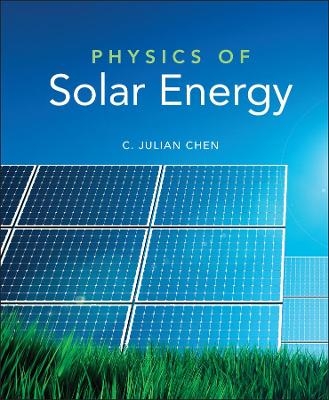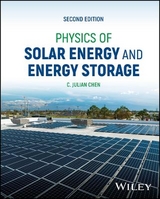
Physics of Solar Energy
John Wiley & Sons Inc (Verlag)
978-0-470-64780-6 (ISBN)
- Titel erscheint in neuer Auflage
- Artikel merken
PHYSICS OF Solar Energy Science/Physics/Energy
The definitive guide to the science of solar energy
You hold in your hands the first, and only, truly comprehensive guide to the most abundant and most promising source of alternative energy—solar power.
In recent years, all major countries in the world have been calling for an energy revolution. The renewable energy industry will drive a vigorous expansion of the global economy and create more “green” jobs. The use of fossil fuels to power our way of living is moving toward an inevitable end, with sources of coal, petroleum, and natural gas being fiercely depleted.
Solar energy offers a ubiquitous, inexhaustible, clean, and highly efficient way of meeting the energy needs of the twenty-first century. This book is designed to give the reader a solid footing in the general and basic physics of solar energy, which will be the basis of research and development in new solar engineering technologies in the years to come.
As solar technologies like solar cells, solar thermal power generators, solar water heaters, solar photochemistry applications, and solar space heating-cooling systems become more and more prominent, it has become essential that the next generation of energy experts—both in academia and industry—have a one-stop resource for learning the basics behind the science, applications, and technologies afforded by solar energy. This book fills that need by laying the groundwork for the projected rapid expansion of future solar projects.
C. JULIAN CHEN is an Adjunct Professor and Senior Research Scientist in the Department of Applied Physics and Applied Mathematics at Columbia University. His research interests include scanning tunneling microscopy, mathematical models of the human voice, and utilization of solar energy. Before going into academia, he spent fifteen years in IBM’s Thomas J. Watson Research Center, where he authored Introduction to Scanning Tunneling Microscopy and invented a widely used algorithm for Chinese language speech recognition.
Preface xv
List of Figures xix
List of Tables xxv
Chapter 1: Introduction 1
1.1 Solar Energy 1
1.2 Go beyond Petroleum 5
1.3 Other Renewable Energy Resources 8
1.3.1 Hydroelectric Power 9
1.3.2 Wind Power 11
1.3.3 Biomass and Bioenergy 14
1.3.4 Shallow Geothermal Energy 19
1.3.5 Deep Geothermal Energy 20
1.4 Solar Photovoltaics Primer 22
1.4.1 Birth of Modern Solar Cells 22
1.4.2 Some Concepts on Solar Cells 24
1.4.3 Types of Solar Cells 25
1.4.4 Energy Balance 25
1.5 Above Physics 26
1.5.1 Economics of Solar Energy 27
1.5.2 Moral Equivalence of War 29
1.5.3 Solar Water Heaters over the World 31
1.5.4 Photovoltaics: Toward Grid Parity 35
Problems 40
Chapter 2: Nature of Solar Radiation 41
2.1 Light as Electromagnetic Waves 41
2.1.1 Maxwell’s Equations 42
2.1.2 Vector Potential 43
2.1.3 Electromagnetic Waves 43
2.1.4 Plane Waves 44
2.1.5 Polarization of Light 45
2.1.6 Motion of an Electron in Electric and Magnetic Fields 46
2.2 Optics of Thin Films 47
2.2.1 Relative Dielectric Constant and Refractive Index 48
2.2.2 Energy Balance and Poynting Vector 49
2.2.3 Fresnel Formulas 50
2.3 Blackbody Radiation 52
2.3.1 Rayleigh–Jeans Law 53
2.3.2 Planck Formula and Stefan–Boltzmann’s Law 55
2.4 Photoelectric Effect and Concept of Photons 58
2.4.1 Einstein’s Theory of Photons 60
2.4.2 Millikan’s Experimental Verification 61
2.4.3 Wave–Particle Duality 62
2.5 Einstein’s Derivation of Blackbody Formula 63
Problems 65
Chapter 3: Origin of Solar Energy 67
3.1 Basic Parameters of the Sun 68
3.1.1 Distance 68
3.1.2 Mass 68
3.1.3 Radius 68
3.1.4 Emission Power 69
3.1.5 Surface Temperature 69
3.1.6 Composition 70
3.2 Kelvin–Helmholtz Time Scale 70
3.3 Energy Source of the Sun 72
3.3.1 The p − p Chain 73
3.3.2 Carbon Chain 74
3.3.3 Internal Structure of the Sun 74
Problems 74
Chapter 4: Tracking Sunlight 77
4.1 Rotation of Earth: Latitude and Longitude 77
4.2 Celestial Sphere 78
4.2.1 Coordinate Transformation: Cartesian Coordinates 81
4.2.2 Coordinate Transformation: Spherical Trigonometry 83
4.3 Treatment in Solar Time 84
4.3.1 Obliquity and Declination of the Sun 84
4.3.2 Sunrise and Sunset Time 86
4.3.3 Direct Solar Radiation on an Arbitrary Surface 87
4.3.4 Direct Daily Solar Radiation Energy 88
4.3.5 The 24 Solar Terms 94
4.4 Treatment in Standard Time 95
4.4.1 Sidereal Time and Solar Time 95
4.4.2 Right Ascension of the Sun 97
4.4.3 Time Difference Originated from Obliquity 97
4.4.4 Aphelion and Perihelion 98
4.4.5 Time Difference Originated from Eccentricity 99
4.4.6 Equation of Time 100
4.4.7 Declination of the Sun 102
4.4.8 Analemma 102
Problems 103
Chapter 5: Interaction of Sunlight with Earth 105
5.1 Interaction of Radiation with Matter 105
5.1.1 Absorptivity, Reflectivity, and Transmittivity 105
5.1.2 Emissivity and Kirchhoff’s Law 106
5.1.3 Bouguer–Lambert–Beer’s Law 107
5.2 Interaction of Sunlight with Atmosphere 108
5.2.1 AM1.5 Reference Solar Spectral Irradiance 109
5.2.2 Annual Insolation Map 111
5.2.3 Clearness Index 111
5.2.4 Beam and Diffuse Solar Radiation 112
5.3 Penetration of Solar Energy into Earth 114
Problems 117
Chapter 6: Thermodynamics of Solar Energy 119
6.1 Definitions 119
6.2 First Law of Thermodynamics 121
6.3 Second Law of Thermodynamics 123
6.3.1 Carnot Cycle 123
6.3.2 Thermodynamic Temperature 126
6.3.3 Entropy 127
6.4 Thermodynamic Functions 127
6.4.1 Free Energy 128
6.4.2 Enthalpy 128
6.4.3 Gibbs Free Energy 129
6.4.4 Chemical Potential 129
6.5 Ideal Gas 130
6.6 Ground Source Heat Pump and Air Conditioning 133
6.6.1 Theory 133
6.6.2 Coefficient of Performance 135
6.6.3 Vapor-Compression Heat Pump and Refrigerator 135
6.6.4 Ground Heat Exchanger 138
Problems 142
Chapter 7: Quantum Transitions 143
7.1 Basic Concepts of Quantum Mechanics 143
7.1.1 Quantum States: Energy Levels and Wavefunctions 143
7.1.2 Dynamic Variables and Equation of Motion 144
7.1.3 One-Dimensional Potential Well 146
7.1.4 Hydrogen Atom 148
7.2 Many-Electron Systems 150
7.2.1 Single-Electron Approximation 150
7.2.2 Direct Observation of Quantum States 151
7.2.3 Quantum States of Molecules: HOMO and LUMO 152
7.2.4 Quantum States of a Nanocrystal 153
7.3 The Golden Rule 154
7.3.1 Time-Dependent Perturbation by Periodic Disturbance 155
7.3.2 Golden Rule for Continuous Spectrum 157
7.3.3 Principle of Detailed Balance 158
7.4 Interactions with Photons 159
Problems 160
Chapter 8: pn-Junctions 161
8.1 Semiconductors 161
8.1.1 Conductor, Semiconductor, and Insulator 161
8.1.2 Electrons and Holes 162
8.1.3 p-Type and n-Type Semiconductors 164
8.2 Formation of a pn-Junction 166
8.3 Analysis of pn-Junctions 170
8.3.1 Effect of Bias Voltage 171
8.3.2 Lifetime of Excess Minority Carriers 172
8.3.3 Junction Current 172
8.3.4 Shockley Equation 173
Problems 176
Chapter 9: Semiconductor Solar Cells 177
9.1 Basic Concepts 177
9.1.1 Generation of Electric Power 180
9.1.2 Solar Cell Equation 181
9.1.3 Maximum Power and Fill Factor 182
9.2 The Shockley–Queisser Limit 183
9.2.1 Ultimate Efficiency 184
9.2.2 Role of Recombination Time 186
9.2.3 Detailed-Balance Treatment 186
9.2.4 Nominal Efficiency 189
9.2.5 Shockley–Queisser Efficiency Limit 189
9.2.6 Efficiency Limit for AM1.5 Radiation 190
9.3 Nonradiative Recombination Processes 191
9.3.1 Auger Recombination 193
9.3.2 Trap-State Recombination 193
9.3.3 Surface-State Recombination 194
9.4 Antireflection Coatings 194
9.4.1 Matrix Method 195
9.4.2 Single-Layer Antireflection Coating 197
9.4.3 Double-Layer Antireflection Coatings 199
9.5 Crystalline Silicon Solar Cells 200
9.5.1 Production of Pure Silicon 201
9.5.2 Solar Cell Design and Processing 202
9.5.3 Module Fabrication 203
9.6 Thin-Film Solar Cells 204
9.6.1 CdTe Solar Cells 204
9.6.2 CIGS Solar Cells 205
9.6.3 Amorphous Silicon Thin-Film Solar Cells 206
9.7 Tandem Solar Cells 207
Problems 209
Chapter 10: Solar Electrochemistry 211
10.1 Physics of Photosynthesis 211
10.1.1 Chlorophyll 212
10.1.2 ATP: Universal Energy Currency of Life 214
10.1.3 NADPH and NADP+ 214
10.1.4 Calvin Cycle 215
10.1.5 C4 Plants versus C3 Plants 216
10.1.6 Chloroplast 216
10.1.7 Efficiency of Photosynthesis 217
10.2 Artificial Photosynthesis 219
10.3 Genetically Engineered Algae 219
10.4 Dye-Sensitized Solar Cells 219
10.5 Bilayer Organic Solar Cells 222
Problems 224
Chapter 11: Solar Thermal Energy 225
11.1 Early Solar Thermal Applications 225
11.2 Solar Heat Collectors 228
11.2.1 Selective Absorption Surface 228
11.2.2 Flat-Plate Collectors 232
11.2.3 All-Glass Vacuum-Tube Collectors 236
11.2.4 Thermosiphon Solar Heat Collectors 238
11.2.5 High-Pressure Vacuum Tube Collectors 240
11.3 Solar Water Heaters 240
11.3.1 System with Thermosiphon Solar Heat Collectors 241
11.3.2 System with Pressurized Heat-Exchange Coils 241
11.3.3 System with a Separate Heat-Exchange Tank 242
11.4 Solar Thermal Power Systems 242
11.4.1 Parabolic Trough Concentrator 243
11.4.2 Central Receiver with Heliostats 244
11.4.3 Paraboloidal Dish Concentrator with Stirling Engine 245
11.4.4 Integrated Solar Combined Cycle 247
11.4.5 Linear Fresnel Reflector (LFR) 248
Problems 250
Chapter 12: Energy Storage 253
12.1 Sensible Heat Energy Storage 253
12.1.1 Water 254
12.1.2 Solid Sensible Heat Storage Materials 256
12.1.3 Synthetic Oil in Packed Beds 257
12.2 Phase Transition Thermal Storage 257
12.2.1 Water–Ice Systems 258
12.2.2 Paraffin Wax and Other Organic Materials 261
12.2.3 Salt Hydrates 261
12.2.4 Encapsulation of PCM 261
12.3 Rechargeable Batteries 262
12.3.1 Electrochemistry of Rechargeable Batteries 263
12.3.2 Lead–Acid Batteries 264
12.3.3 Nickel Metal Hydride Batteries 265
12.3.4 Lithium-Ion Batteries 266
12.3.5 Mineral Resource of Lithium 268
12.4 Solar Energy and Electric Vehicles 269
Problems 272
Chapter 13: Building with Sunshine 273
13.1 Early Solar Architecture 274
13.1.1 Ancient Solar Architecture 274
13.1.2 Holistic Architecture in Rural China 274
13.2 Building Materials 275
13.2.1 Thermal Resistance 276
13.2.2 Specific Thermal Resistance 276
13.2.3 Heat Transfer Coefficient: the U-Value 277
13.2.4 Thermal Mass 278
13.2.5 Glazing 278
13.3 Example of Holistic Design 280
13.4 Land Usage of Solar Communities 283
Problems 286
Appendix A: Energy Unit Conversion 287
Appendix B: Spherical Trigonometry 289
B.1 Spherical Triangle 289
B.2 Cosine Formula 290
B.3 Sine Formula 291
B.4 Formula C 292
Problems 294
Appendix C: Quantum Mechanics Primer 295
C.1 Harmonic Oscillator 295
C.2 Angular Momentum 297
C.3 Hydrogen Atom 300
Appendix D: Statistics of Particles 303
D.1 Maxwell–Boltzmann Statistics 304
D.2 Fermi–Dirac Statistics 306
Appendix E: AM1.5 Reference Solar Spectrum 307
List of Symbols 313
Bibliography 315
Index 321
| Zusatzinfo | Photos: 53 B&W, 19 Color; Drawings: 159 B&W, 0 Color |
|---|---|
| Verlagsort | New York |
| Sprache | englisch |
| Maße | 198 x 244 mm |
| Gewicht | 803 g |
| Themenwelt | Technik ► Elektrotechnik / Energietechnik |
| Technik ► Maschinenbau | |
| ISBN-10 | 0-470-64780-9 / 0470647809 |
| ISBN-13 | 978-0-470-64780-6 / 9780470647806 |
| Zustand | Neuware |
| Haben Sie eine Frage zum Produkt? |
aus dem Bereich



